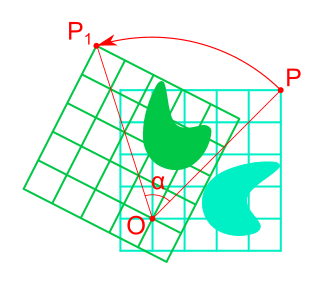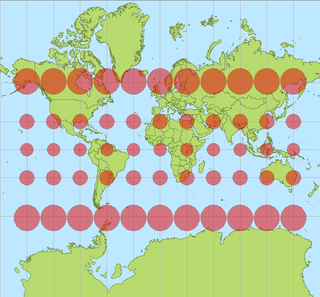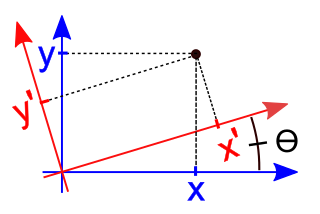This article needs additional citations for verification .(July 2023) |
In Euclidean geometry, two-dimensional rotations and reflections are two kinds of Euclidean plane isometries which are related to one another.
This article needs additional citations for verification .(July 2023) |
In Euclidean geometry, two-dimensional rotations and reflections are two kinds of Euclidean plane isometries which are related to one another.
A rotation in the plane can be formed by composing a pair of reflections. First reflect a point P to its image P′ on the other side of line L1. Then reflect P′ to its image P′′ on the other side of line L2. If lines L1 and L2 make an angle θ with one another, then points P and P′′ will make an angle 2θ around point O, the intersection of L1 and L2. I.e., angle ∠ POP′′ will measure 2θ.
A pair of rotations about the same point O will be equivalent to another rotation about point O. On the other hand, the composition of a reflection and a rotation, or of a rotation and a reflection (composition is not commutative), will be equivalent to a reflection.
The statements above can be expressed more mathematically. Let a rotation about the origin O by an angle θ be denoted as Rot(θ). Let a reflection about a line L through the origin which makes an angle θ with the x-axis be denoted as Ref(θ). Let these rotations and reflections operate on all points on the plane, and let these points be represented by position vectors. Then a rotation can be represented as a matrix,
and likewise for a reflection,
With these definitions of coordinate rotation and reflection, the following four identities hold:
These equations can be proved through straightforward matrix multiplication and application of trigonometric identities, specifically the sum and difference identities.
The set of all reflections in lines through the origin and rotations about the origin, together with the operation of composition of reflections and rotations, forms a group. The group has an identity: Rot(0). Every rotation Rot(φ) has an inverse Rot(−φ). Every reflection Ref(θ) is its own inverse. Composition has closure and is associative, since matrix multiplication is associative.
Notice that both Ref(θ) and Rot(θ) have been represented with orthogonal matrices. These matrices all have a determinant whose absolute value is unity. Rotation matrices have a determinant of +1, and reflection matrices have a determinant of −1.
The set of all orthogonal two-dimensional matrices together with matrix multiplication form the orthogonal group: O(2).
The following table gives examples of rotation and reflection matrix :
| Type | angle θ | matrix |
|---|---|---|
| Rotation | 0° | |
| Rotation | 45° | |
| Rotation | 90° | |
| Rotation | 180° | |
| Reflection | 0° | |
| Reflection | 45° | |
| Reflection | 90° | |
| Reflection | -45° |


2D computer graphics is the computer-based generation of digital images—mostly from two-dimensional models and by techniques specific to them. It may refer to the branch of computer science that comprises such techniques or to the models themselves.
In linear algebra, an orthogonal matrix, or orthonormal matrix, is a real square matrix whose columns and rows are orthonormal vectors.

An ellipsoid is a surface that can be obtained from a sphere by deforming it by means of directional scalings, or more generally, of an affine transformation.

In mathematics, the orthogonal group in dimension n, denoted O(n), is the group of distance-preserving transformations of a Euclidean space of dimension n that preserve a fixed point, where the group operation is given by composing transformations. The orthogonal group is sometimes called the general orthogonal group, by analogy with the general linear group. Equivalently, it is the group of n × n orthogonal matrices, where the group operation is given by matrix multiplication (an orthogonal matrix is a real matrix whose inverse equals its transpose). The orthogonal group is an algebraic group and a Lie group. It is compact.
In mechanics and geometry, the 3D rotation group, often denoted SO(3), is the group of all rotations about the origin of three-dimensional Euclidean space under the operation of composition.

Rotation in mathematics is a concept originating in geometry. Any rotation is a motion of a certain space that preserves at least one point. It can describe, for example, the motion of a rigid body around a fixed point. Rotation can have a sign (as in the sign of an angle): a clockwise rotation is a negative magnitude so a counterclockwise turn has a positive magnitude. A rotation is different from other types of motions: translations, which have no fixed points, and (hyperplane) reflections, each of them having an entire (n − 1)-dimensional flat of fixed points in a n-dimensional space.
An infinitesimal rotation matrix or differential rotation matrix is a matrix representing an infinitely small rotation.

In mathematics, the circle group, denoted by or , is the multiplicative group of all complex numbers with absolute value 1, that is, the unit circle in the complex plane or simply the unit complex numbers
In linear algebra, linear transformations can be represented by matrices. If is a linear transformation mapping to and is a column vector with entries, then
In linear algebra, a rotation matrix is a transformation matrix that is used to perform a rotation in Euclidean space. For example, using the convention below, the matrix

In geometry, Euler's rotation theorem states that, in three-dimensional space, any displacement of a rigid body such that a point on the rigid body remains fixed, is equivalent to a single rotation about some axis that runs through the fixed point. It also means that the composition of two rotations is also a rotation. Therefore the set of rotations has a group structure, known as a rotation group.
In linear algebra, an orthogonal transformation is a linear transformation T : V → V on a real inner product space V, that preserves the inner product. That is, for each pair u, v of elements of V, we have
Spatial rotations in three dimensions can be parametrized using both Euler angles and unit quaternions. This article explains how to convert between the two representations. Actually this simple use of "quaternions" was first presented by Euler some seventy years earlier than Hamilton to solve the problem of magic squares. For this reason the dynamics community commonly refers to quaternions in this application as "Euler parameters".
In geometry, a Euclidean plane isometry is an isometry of the Euclidean plane, or more informally, a way of transforming the plane that preserves geometrical properties such as length. There are four types: translations, rotations, reflections, and glide reflections.

In cartography, a Tissot's indicatrix is a mathematical contrivance presented by French mathematician Nicolas Auguste Tissot in 1859 and 1871 in order to characterize local distortions due to map projection. It is the geometry that results from projecting a circle of infinitesimal radius from a curved geometric model, such as a globe, onto a map. Tissot proved that the resulting diagram is an ellipse whose axes indicate the two principal directions along which scale is maximal and minimal at that point on the map.

In mathematics, a rotation of axes in two dimensions is a mapping from an xy-Cartesian coordinate system to an x′y′-Cartesian coordinate system in which the origin is kept fixed and the x′ and y′ axes are obtained by rotating the x and y axes counterclockwise through an angle . A point P has coordinates (x, y) with respect to the original system and coordinates (x′, y′) with respect to the new system. In the new coordinate system, the point P will appear to have been rotated in the opposite direction, that is, clockwise through the angle . A rotation of axes in more than two dimensions is defined similarly. A rotation of axes is a linear map and a rigid transformation.
In geometry, various formalisms exist to express a rotation in three dimensions as a mathematical transformation. In physics, this concept is applied to classical mechanics where rotational kinematics is the science of quantitative description of a purely rotational motion. The orientation of an object at a given instant is described with the same tools, as it is defined as an imaginary rotation from a reference placement in space, rather than an actually observed rotation from a previous placement in space.

In mathematics, the axis–angle representation parameterizes a rotation in a three-dimensional Euclidean space by two quantities: a unit vector e indicating the direction (geometry) of an axis of rotation, and an angle of rotation θ describing the magnitude and sense of the rotation about the axis. Only two numbers, not three, are needed to define the direction of a unit vector e rooted at the origin because the magnitude of e is constrained. For example, the elevation and azimuth angles of e suffice to locate it in any particular Cartesian coordinate frame.

In mechanical engineering, the Denavit–Hartenberg parameters are the four parameters associated with a particular convention for attaching reference frames to the links of a spatial kinematic chain, or robot manipulator.
In physics and engineering, Davenport chained rotations are three chained intrinsic rotations about body-fixed specific axes. Euler rotations and Tait–Bryan rotations are particular cases of the Davenport general rotation decomposition. The angles of rotation are called Davenport angles because the general problem of decomposing a rotation in a sequence of three was studied first by Paul B. Davenport.